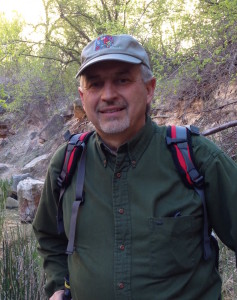by Paul Parker for EDRblog.org.
With over 100 groups, involved in environmental education (EE) in Utah, why don’t we talk to each other about issues and best practices?

More than 50 environmental, government and educational leaders met to share their experiences and expertise in environmental education
This is exactly what HawkWatch International and the Utah Society for Environmental Education set out to do when we organized a 2-day Roundtable of over 50 environmental, government and educational leaders to meet at Tracy Aviary on Earth Day to share EE experiences and expertise. We discussed developing a common Utah charter of guiding principles for effective and responsible EE in Utah.
The attendees listed below represent a broad diversity of organizations that employ a variety of methods, approaches and strategies to communicate with Utah citizens to raise awareness, increase knowledge or motivate the general public to learn about and become responsible stewards of the natural world.
| Federal, State & Local Agencies | Environmental & Other Advocacy Groups | Educational Organizations |
| Bureau of Land Management | Southern UT Wilderness Alliance | Envision UT |
| UT Division of Wildlife Resources | The Nature Conservancy | UCAIR |
| UT Parks Division | UT Rivers Council | Ogden Nature Center |
| Jordan River Commission | Breathe Utah | Utah’s Hogle Zoo |
| SLC Office of Sustainability | Physicians for a Healthy Environment | Natural History Museum of UT |
| Summit Land Conservancy | Sierra Club | Loveland Living Planet Aquarium |
| Utah Transit Authority | Great Salt Lake Audubon | Thanksgiving Point |
| Tree UT | HawkWatch International | |
| Interfaith Power & Light | Utah Society for Environmental Education | |
| LDS Earth Stewardship | Tracy Aviary | |
| Utah ATV Association | Community Foundation of UT | |
| Rocky Elk Foundation | University of Utah |
Why is EE in UT important?
Utah is blessed with an amazing abundance of natural resources, recreational opportunities and diversity of incredible landscapes. The Utah pioneers traveled hundreds of grueling miles by covered wagon and hand carts to settle in this place and then worked as a community to build homes, farms, irrigation systems and self sufficient communities based on faith and common management of natural resources.
Today we enjoy the fruits of their collective labors with modern infrastructure that supports economic development, parks, farms and recreation. There are a lot more Utahns now and we exert a much greater impact on our natural resources than early settlers. It is fair to say that we love our outdoors and enjoy a full range of activities and pursuits, but when it comes to engaging in and responding to environmental and public health concerns there is often a cultural disconnect or divide that seems like a battle between “them and us”.
Where is the authentic Utah environmental ethic founded on historical pioneer values and the realities of today’s natural resource use?
Our political leaders have historically opposed environmental initiatives and we often hear of environmental extremists who don’t reflect our values. It is as though environmental conservation is an import from some other place and disconnected from our history and our use and appreciation of the State’s natural resources.
How do organizations, concerned about our shared environment, connect with the Utah population in a more effective way and collaborate to encourage and shape a Utah environmental ethic?
In addition to sharing information about their organizations and their experiences with EE programs, Roundtable participants produced a draft joint document to guide and enhance Utah EE methods and messages. As envisioned, the Charter will be composed of two separate but related components. The first is a simple set of guidelines and recommendations for connecting with cultural values and producing effective messages that inform motivate and help build a stronger Utah environmental ethic. The second component will include a set of principles, values and standards for ensuring ethics and accountability in EE programs and initiatives. Our goal was to arrive at a consensus in producing a Charter that all organizations could adopt and adhere to in their individual EE efforts.
Through two days of presentations and discussions facilitated (by a professional neutral) we concluded that common ground did exist and that a core group of stakeholders wanted to contribute to the development of an EE Charter. We received a lot of great feedback on the initial draft and are now working with the steering committee to review it and seek additional comments from Roundtable participants. We hope to produce a printed Charter this summer that carries the names of this broad coalition of organizations and can be distributed to their members and applied in individual EE activities and programs. And hopefully this collaborative initiative will help us all develop an authentic environmental ethic for the State of Utah.
 We appreciate the participation and support of the steering committee, the participants and especially our project sponsors: the Utah Division of Wildlife Resources, BLM, and our host, Tracy Aviary.
We appreciate the participation and support of the steering committee, the participants and especially our project sponsors: the Utah Division of Wildlife Resources, BLM, and our host, Tracy Aviary.
Paul Parker graduated in landscape architecture and environmental planning from Utah State University and Harvard University. Before joining HawkWatch International as Executive Director he worked as an environmental consultant, executive director of the Institute/Center for Resource Management and in the Utah State Planning Coordinator’s Office. He lives in Holladay, Utah with his wife, Colleen.
